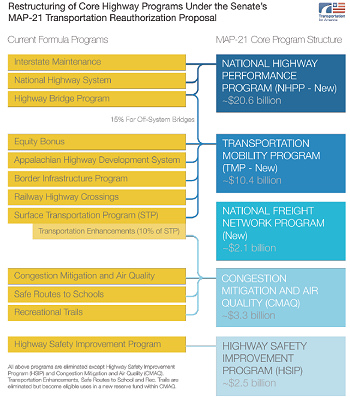[Update: The reauthorization bill was adopted by the EPW Committee today on an 18-0 vote, with one package of amendments adopted. Importantly, the CMAQ “reserve fund” that is a (more-or-less) dedicated source for bike/ped funding can no longer pay for road projects.]
The 2-year transportation reauthorization bill released by the Senate’s Environment and Public Works Committee late Friday night includes several promising reforms that would help focus State DOTs on repair and safety, and for the first time would dedicate money to a freight program. It appears to maintain the conventional 80/20 split between roads and public transit. But the bill, which is known as MAP-21, would cut bike and pedestrian funding by 30% and as currently written would allow states to transfer bike/ped funding for wetlands mitigation. The EPW Committee began work on the bill today.

The bill, known as MAP-21, completely eliminates earmarks and consolidates federal transportation programs from 90 to 30 (a summary is available from T4America). There would be five core programs:
- National Highway Performance Program ($20.6B/year) – Focused on the National Highway System. Importantly, it includes performance measures to incentivize road and bridge repair. Sixty percent of funds would be required to be used for repair. States not meeting federal road and bridge standards would have to use an additional 30% for repair or face financial penalties.
- Transportation Mobility Program ($10.4B) – the successor to the Surface Transportation Program, this would be a highly flexible program for roads, transit, bike/ped, and (for the first time) freight rail.
- Highway Safety Improvement Program ($2.5B) – This existing program is intended to improve safety. It requires states to collect extensive crash data and develop strategic safety plans.
- Congestion Mitigation and Air Quality ($3.3B) – This existing program, focused on reducing air pollution, would become the new home for a smaller bike and pedestrian fund; see below.
- National Freight Program ($2.1B) – This new program would pay for road projects with a freight focus; up to 10% could go to freight rail and ports.
The bill would essentially cut bike and pedestrian funding by 30%. It would do away with the dedicated Transportation Enhancements, Safe Routes to School, and Recreational Trails programs. Instead, those uses would be paid for by a “reserve” or “Additional Activities” fund under the CMAQ program. This fund (which pays for all three of those programs) would be $833 million, the same size as Transportation Enhancements alone in 2009.
Furthermore, Transportation Enhancements could be used to pay for certain types of wetlands mitigation. This expensive use could crowd out spending on bike and pedestrian improvements. The bill would also allow states to “opt out”; by not spending reserve funds for 18 months, a state could then use the funds for other CMAQ projects.
In addition, the bill expands the TIFIA innovative financing program to $1 billion a year and includes some measures to speed up project delivery.
Several amendments to the bill are expected to be offered today on topics including bike/ped funding, freight, and passenger rail. None are expected to pass, but they could reappear later if the bill reaches the Senate floor.
It may be some time before that happens. The Senate’s EPW Committee has jurisdiction over road, bridge, and bicycle and pedestrian funding. If the committee passes a bill, it would then go to the Banking, Housing, and Urban Affairs Committee, which deals with public transit. The Commerce Committee would complete the bill by writing the parts on freight rail, passenger rail, and USDOT’s “discretionary” programs like the innovative TIGER grant program. And paying for the bill is up to the Finance Committee, which has not yet found a way to do so. Beyond that, the House wants to pay for its 6-year transportation bill with oil-drilling fees, a proposal with little shot of passing the Senate.
Graphic: Via Transportation for America.

A cutback on bicycle and pedestrian funding is not unexpected, however, the size of the proposed cut is scary. I also feel that giving states a way out to use funds for wetlands mitigation is setting a bad precedent. It is better to have the TE program set up the way it was, with some funding dedicated for recreational paths/trails only. Creating loopholes will mean that some states will try to use scarce funds for non-path, non bicycle/pedestrian projects. There are too many people in congress and elsewhere who would like to shut down all bicycle and pedestrian project funding.
This is ridiculous. For years, transit asked for a level playing field and must fight to keep it. The leftover crumbs that go to bike and pedestrian projects are not at all in keeping with maintaining the quality of life, addressing global warming and caring for the citizens of the United States.
Bike and pedestrians are being slaughtered every year by motorists (many who should not even have a license)to drive a lethal weapon.
We need people to contact Congress to restore dedicated funding to alternative modes of transportation, Safe routes to School, etc.
[…] the changes introduced in MAP-21, the Senate’s version of the reauthorization bill which sets all federal surface […]
[…] no strong incentives for states to focus their highway dollars on repair (this is in contrast to the Senate version, which abides by the “fix it first” […]
[…] would imperil funding for public transit, pedestrian, and cycling projects. Like the Senate’s MAP-21 bill, the House version consolidates many current transportation programs into a smaller number of […]
[…] While the House bill may be headed back to the drawing board, the Senate is likely to keep its MAP-21 transportation bill at the top of the agenda when Congress returns to work next week. However, […]
[…] MTR has previously explained, MAP-21 consolidates many of the existing road, bridge, and bike/pedestrian programs into five core […]